Comprehensive analysis of the application scenarios of optical modules
2022/2/15 11:49:23
Comprehensive analysis of the application scenarios of optical modules
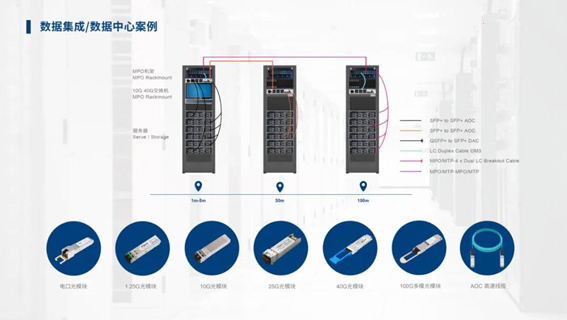
I. Data Center.
The current data center is no longer just one or a few server rooms, but a group of data center clusters. In order to realize the normal work of various Internet services and application markets, it is required that the data centers operate in collaboration with each other. The massive interaction of information between data centers in real time creates the demand for data center interconnection network, and fiber optic communication becomes a necessary means to achieve interconnection. The connection between servers, between switches, and between servers and switches requires the use of Hongteng's optical modules (direct copper cable, active optical cable), fiber optic patch cords, and other transmission carriers to achieve data interoperability.
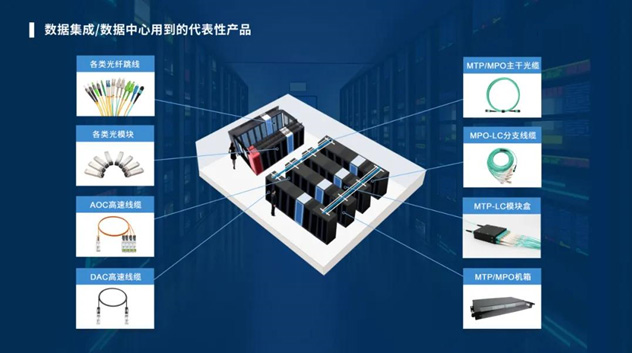
Unlike traditional telecom access network transmission equipment, data center interconnection to achieve a greater amount of information, more intensive transmission, requires switching equipment with higher speed, lower power consumption, and more miniaturization. A central factor in determining whether these capabilities can be achieved is the optical module.
Data center communication optical modules can be divided into three categories according to the type of connection.
(1) Data center to user, generated by accessing the cloud for end-user actions such as browsing the web, sending and receiving emails and video streaming;
(2) Data center interconnections, mainly for data replication, software and system upgrades;
(3) Inside the data center, mainly for information storage, generation and mining. According to Cisco's forecast, internal data center communication accounts for more than 70% of data center communication, and the great development of data center construction has given rise to the development of high-speed optical modules.
With the growing market demand for data transmission, IDC rooms can enhance the business competitiveness of SMEs. The diversification of data center interconnection scenarios and the individualization of customer needs have given rise to different types of network equipment and transmission carriers (active optical cables, directly connected copper cables, optical modules, fiber optic patch cords), so users need to choose the relevant equipment or accessories according to the actual application scenarios before making a choice.
Second, mobile communication base station.
Mobile communication base station, refers to a certain radio coverage area, through the mobile communication exchange center, and the mobile phone terminal information transmission between the radio transceiver station.
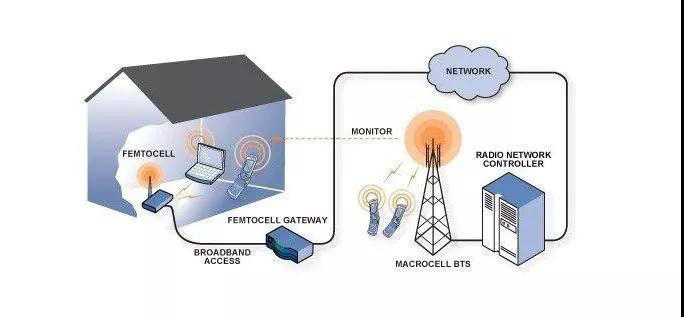
Mobile communication base stations of operators also need optical modules to achieve interconnection between devices, base stations have RRU and BBU devices, in the application, we have to connect the links of these two devices, which requires our optical modules and fiber optic patch cables, in 4G networks, the equipment used to connect BBU and RRU are mainly 1.25G optical module, 2.5G optical module, 6G optical module, 10G optical module, etc.
III. Passive WDM system
Among the technical solutions used in 5G front transmission, passive WDM is undoubtedly the highest percentage. Passive WDM system consists of color optical module, multiplexer and optical fiber.
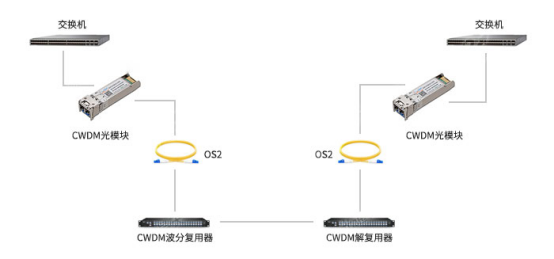
The core principle of passive WDM technology is to use WDM technology to couple optical signals of different wavelengths and containing a series of information into a single bundle for transmission in a single fiber to achieve inter-service transmission. It can transmit each signal with a specific wavelength of light that matches the signal, and then separate these different wavelengths at the receiving end. Passive WDM system is mainly a system composed of color optical module and OTM and two parts.
Fourth, SAN/NAS storage network.
With the rapid development of the Internet and network applications, the type of data to be processed by the data information storage system is also exploding, which makes the data information storage system face unprecedented challenges. Network Attached Storage (NAS) and Storage Area Network (SAN), which can separate data and information storage devices from the network and host system, can centralize the management of information and data, but also have good scalability, providing the most effective solution for centralized data management. Provides the most effective solution for centralized data management.
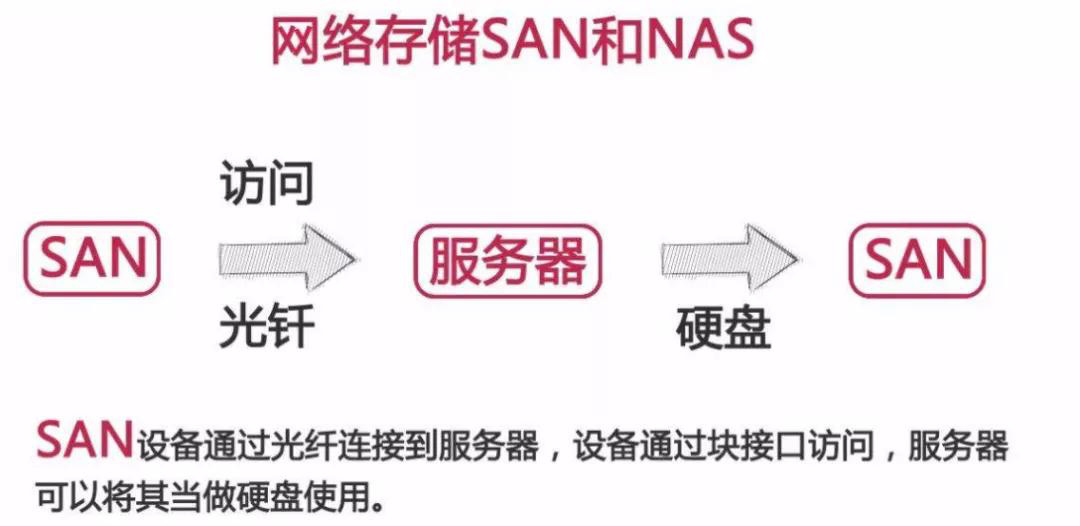
SAN/NAS storage network is mainly used to store data, where the SAN network mainly consists of servers, Fibre Channel switches, storage devices, and transmission carriers (optical modules, fiber optic patch cables); NAS storage network mainly consists of NAS storage, switches, end devices (computers), transmission carriers (optical modules, fiber optic patch cables).
It should be noted that SAN networks use Fibre Channel optical modules, which need to support FC Fibre Channel protocol, while the optical modules used in NAS storage networks only need to comply with the Ethernet protocol.
V. 5G bearer network
5G network is divided into three parts, respectively, the access network, bearer network and core network. The understanding of the relationship between them, you can refer to the following chart.
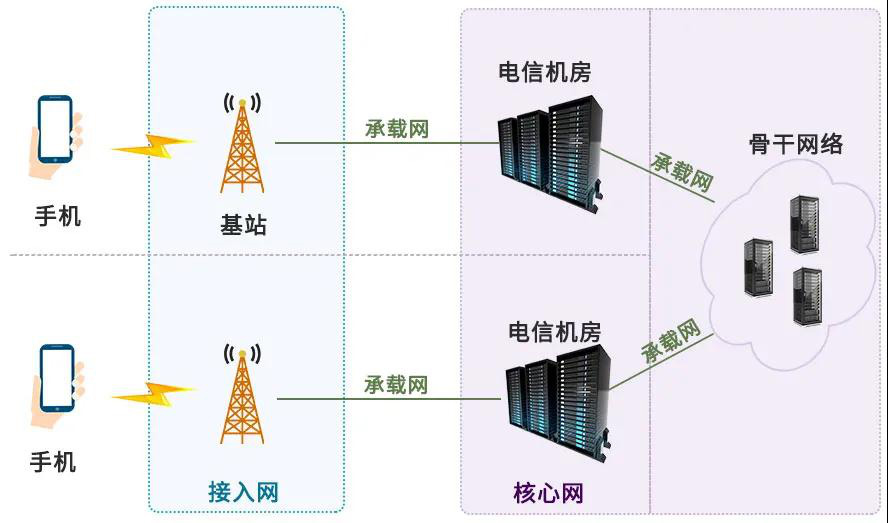
5G bearer network is generally divided into metro access layer, metro convergence layer, metro core layer/provincial trunk, to achieve the 5G service front and back transmission function. 5G front transmission typical application scenarios, including fiber direct connection, passive WDM and active WDM, etc.
Typical requirements for optical modules in 5G front transmission application scenarios are as follows.
①M(fèi)eet industrial grade temperature and high reliability requirements: Considering the outdoor working environment, the front transmission optical module must meet the industrial grade temperature range of -40℃~+85℃, and also needs to meet the dustproof requirements
②Low cost: 5G optical module demand greatly exceeds 4G, especially the front optical module may have a particularly high demand, low cost is one of the main requirements for optical modules in the 5G industry. 5G backhaul covers the metro access layer, convergence layer and core layer, the required optical The optical modules required for 5G backhaul cover the metro access, convergence and core layers, and the optical modules required are not very different from those currently used in data centers, with the access layer mainly using optical modules at 25Gb/s, 50Gb/s and 100Gb/s, and the convergence layer and above using more DWDM modules at 100Gb/s, 200Gb/s and 400Gb/s. /s and other rates of DWDM optical modules.
Finally, it must be said that the growth demand for optical modules depends mainly on the data communication market and telecommunications market, in today's data era, optical modules are bound to usher in new development opportunities.







